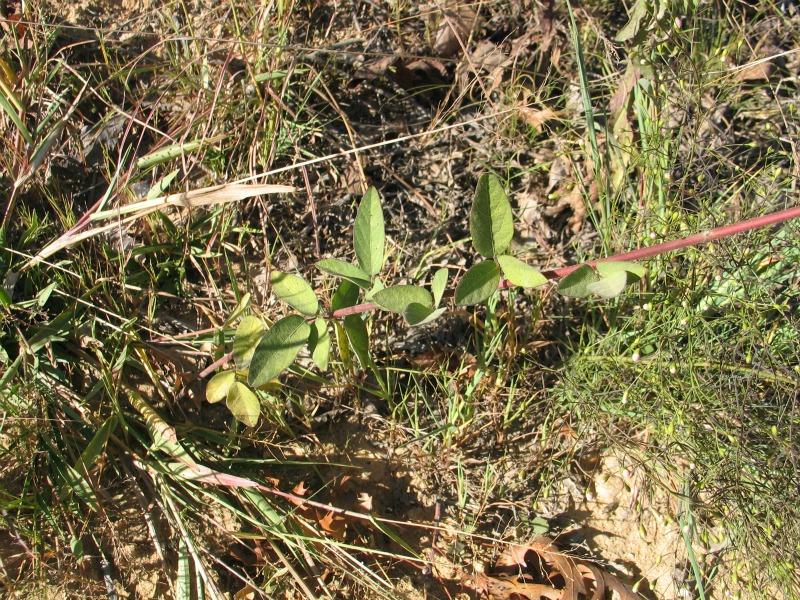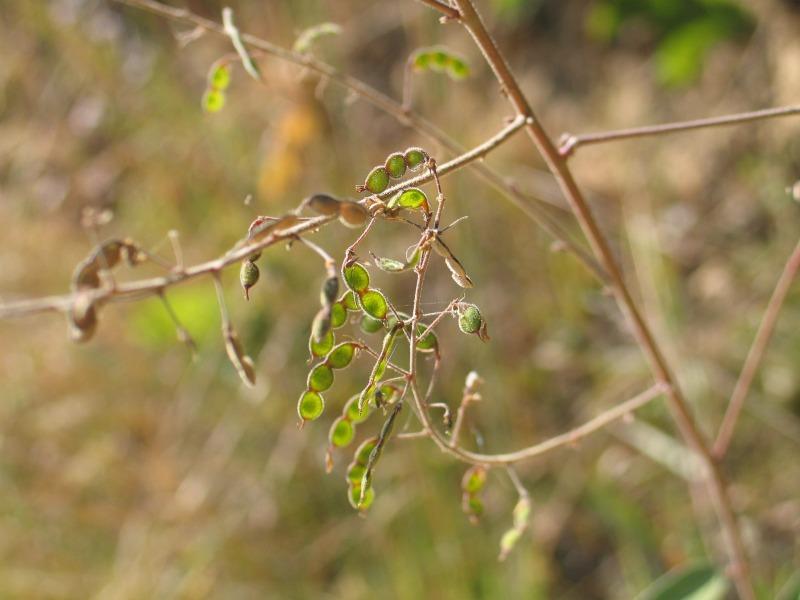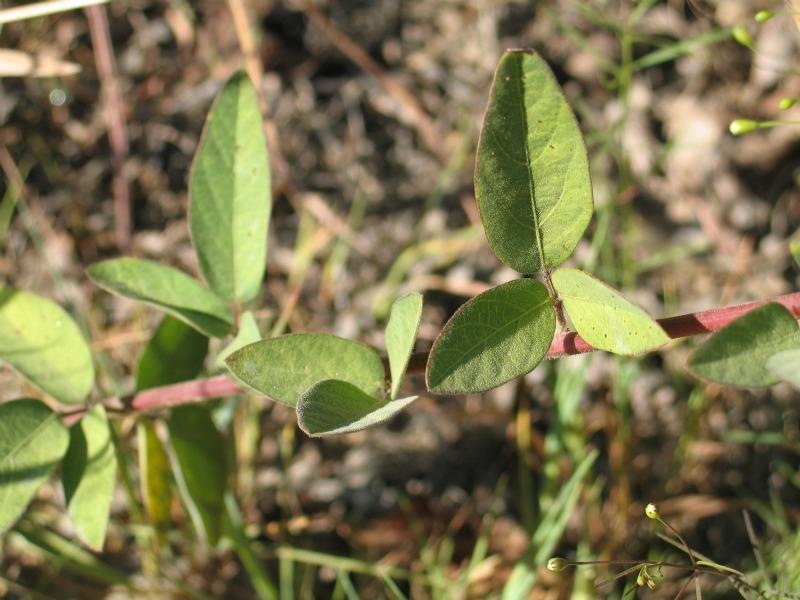Rigid Tick Trefoil
Desmodium obtusum (Muhl. ex Willd.) DC.
- Class
- Dicotyledoneae (Dicots)
- Family
- Fabaceae (Pea Family)
- State Protection
- Endangered
Listed as Endangered by New York State: in imminent danger of extirpation in New York. For animals, taking, importation, transportation, or possession is prohibited, except under license or permit. For plants, removal or damage without the consent of the landowner is prohibited.
- Federal Protection
- Not Listed
- State Conservation Status Rank
- S1
Critically Imperiled in New York - Especially vulnerable to disappearing from New York due to extreme rarity or other factors; typically 5 or fewer populations or locations in New York, very few individuals, very restricted range, very few remaining acres (or miles of stream), and/or very steep declines.
- Global Conservation Status Rank
- G4G5
Apparently or Demonstrably Secure globally - Uncommon to common in the world, but not rare; usually widespread, but may be rare in some parts of its range; possibly some cause for long-term concern due to declines or other factors. More information is needed to assign either G4 or G5.
Summary
Did you know?
The genus name derives from the Greek word desmos, meaning bond or chain, and refers to the connection between the segments of the fruit. The species name refers to the blunt-tipped leaves. The common name of this species is in reference to the fruit's ability to stick to animals like ticks. Trefoil refers to the three stiff leaflets that make up each leaf.
State Ranking Justification
There are three existing populations, one of good quality, one of fair quality and under threat, and one without any quality information. There are four historical records from 1882 to 1906.
Short-term Trends
One population may have been extirpated by development and more information is needed about another population to develop short-term trends.
Long-term Trends
This plant was never common in the state but none of the historical records have been relocated and the existing records are not doing very well.
Conservation and Management
Threats
One population is threatened by development.
Conservation Strategies and Management Practices
The plant's open meadow habitat needs to be maintained by mowing or by fire management. Plants should not be disturbed during the growing season before fruit is set and dispersed.
Research Needs
Not enough is known about this species' response to fire management. More information about seed banking and population augmentation is needed.
Habitat
Habitat
In New York Desmodium obtusum has been collected from a maritime grassland, openings in an oak forest, and a successional old field, where it was associated with asters, goldenrods, and grasses. More information on its habitat requirements in the state is needed (New York Natural Heritage Program 2007). Dry sandy woods (Fernald 1970). Dry woods and thickets (Gleason & Cronquist 1991).
Associated Ecological Communities
- Maritime grassland
(guide)
A grassland community that occurs on rolling outwash plains of the glaciated portion of the Atlantic coastal plain, near the ocean and within the influence of offshore winds and salt spray.
- Oak openings
(guide)
A grass-savanna community that occurs on well-drained soils. In New York, these savannas originally occurred as openings within extensive oak-hickory forests. The best remnants occur on dolomite knobs.
- Successional old field
A meadow dominated by forbs and grasses that occurs on sites that have been cleared and plowed (for farming or development), and then abandoned or only occasionally mowed.
Associated Species
- Berberis thunbergii (Japanese barberry)
- Betula lenta (black birch)
- Desmodium paniculatum (panicled tick-trefoil)
- Desmodium rotundifolium (round-leaved tick-trefoil)
- Lespedeza hirta
- Lespedeza virginica (slender bush-clover)
- Poa compressa (flat-stemmed blue grass, Canada blue grass)
- Prunus pensylvanica (pin cherry, fire cherry)
- Quercus rubra (northern red oak)
- Sassafras albidum (sassafras)
- Schizachyrium scoparium
- Solidago juncea (early goldenrod)
- Solidago nemoralis
- Solidago rugosa
- Symphyotrichum lateriflorum (calico-aster)
- Symphyotrichum racemosum (small white-aster)
- Vaccinium pallidum (hillside blueberry)
Range
New York State Distribution
In New York Stiff Tick-trefoil has been found most often in southeastern New York, from Long Island and New York City to as far north as Ulster County. There are also scattered records from 3 counties in the central and western parts of the state.
Global Distribution
Desmodium obtusum is found in all the states east of the Mississippi River, excepting Maine, Vermont, and Wisconsin. Its range extends slightly west of the Mississippi from Colorado and Nebraska south to Texas.
Identification Comments
General Description
Stiff Tick-trefoil is a perennial herb species of the pea or legume family (Fabaceae). It has erect stems, up to 1.2 m tall and densely hairy. The leaves are compound, divided into 3 leaflets, on petioles shorter than the lateral leaflets. The leaflets are hairy as well, and the terminal (middle) one is 2.5-7 cm long. The flowers have the familiar "winged" shape of the pea family, and are only 4-6 mm long. Their color may range from nearly purple to nearly white. The fruit separate into seeds covered with tiny, hooked hairs, well-dispersed by human socks and pant-legs.
Best Life Stage for Proper Identification
Desmodium obtusum is best identified when flowers or fruit are present.
Similar Species
Desmodium ciliare has a smaller terminal leaflet, averaging 1.5-2.5 cm long. D. marilandicum has lateral leaflets that are about as long as the petiole, and its leaves are glabrous or nearly so.
Best Time to See
Desmodium obtusum flowers from August to mid-September, the fruits persisting to the first frost.
- Vegetative
- Flowering
- Fruiting
The time of year you would expect to find Rigid Tick Trefoil vegetative, flowering, and fruiting in New York.
Rigid Tick Trefoil Images
Taxonomy
Rigid Tick Trefoil
Desmodium obtusum (Muhl. ex Willd.) DC.
- Kingdom Plantae
- Phylum Anthophyta
- Class Dicotyledoneae
(Dicots)
- Order Fabales
- Family Fabaceae (Pea Family)
- Order Fabales
- Class Dicotyledoneae
(Dicots)
- Phylum Anthophyta
Additional Common Names
- Beggar-lice
- Stiff Tick Trefoil
- Tick-trefoil
Synonyms
- Desmodium rigidum (Ell.) DC.
- Hedysarum obtusum Muhl. ex Willd.
- Hedysarum rigidum Ell.
- Meibomia rigida (Ell.) Kuntze
Additional Resources
Best Identification Reference
Rhoads, Ann F. and Timothy A. Block. 2000. The Plants of Pennsylvania, an Illustrated Manual. University of Pennsylvania Press, Philadelphia, PA.
Other References
Fernald, M.L. 1950. Gray's manual of botany. 8th edition. D. Van Nostrand, New York. 1632 pp.
Gleason, Henry A. and A. Cronquist. 1991. Manual of Vascular Plants of Northeastern United States and Adjacent Canada. The New York Botanical Garden, Bronx, New York. 910 pp.
Holmgren, Noel. 1998. The Illustrated Companion to Gleason and Cronquist's Manual. Illustrations of the Vascular Plants of Northeastern United States and Adjacent Canada. The New York Botanical Garden, Bronx, New York.
New York Natural Heritage Program. 2010. Biotics database. New York Natural Heritage Program. New York State Department of Environmental Conservation. Albany, NY.
New York Natural Heritage Program. 2024. New York Natural Heritage Program Databases. Albany, NY.
Voss, E.G. 1985. Michigan Flora. Part II. Dicots (Saururaceae - Cornaceae). Cranbrook Institute of Science and University of Michigan Herbarium. Ann Arbor, Michigan. 724 pp.
Weldy, T. and D. Werier. 2010. New York flora atlas. [S.M. Landry, K.N. Campbell, and L.D. Mabe (original application development), Florida Center for Community Design and Research http://www.fccdr.usf.edu/. University of South Florida http://www.usf.edu/]. New York Flora Association http://newyork.plantatlas.usf.edu/, Albany, New York
Weldy, Troy W. and David Werier. 2005. New York Flora Atlas. [S.M. Landry, K.N. Campbell, and L.D. Mabe (original application development), Florida Center for Community Design and Research. University of South Florida]. New York Flora Association, Albany, NY. Available on the web at (http://newyork.plantatlas.usf.edu/).
Links
About This Guide
Information for this guide was last updated on: August 25, 2020
Please cite this page as:
New York Natural Heritage Program. 2024.
Online Conservation Guide for
Desmodium obtusum.
Available from: https://guides.nynhp.org/stiff-tick-trefoil/.
Accessed July 26, 2024.



